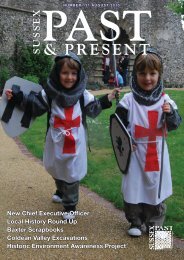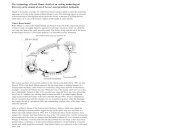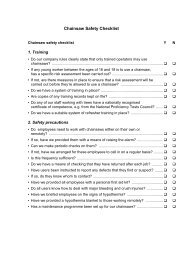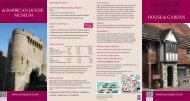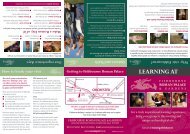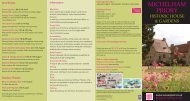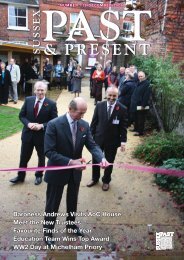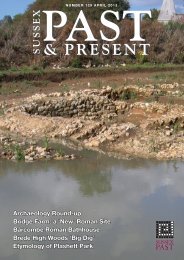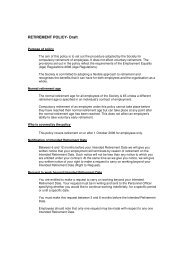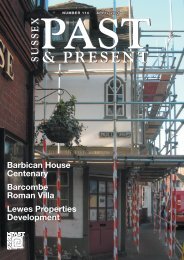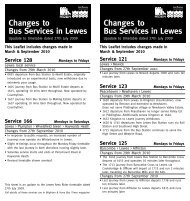NUMBER 117 APRIL 2009 - The Sussex Archaeological Society
NUMBER 117 APRIL 2009 - The Sussex Archaeological Society
NUMBER 117 APRIL 2009 - The Sussex Archaeological Society
- No tags were found...
Create successful ePaper yourself
Turn your PDF publications into a flip-book with our unique Google optimized e-Paper software.
FeatureLEWES DEVELOPMENTSHISTORYResearchLewes Castle works<strong>The</strong> story in picturesLewes Castle works: general view showing the Gun Garden and steps (left).<strong>The</strong> picture of Lewes Castle onthe cover of this issue of SP&P,and the photograph above, weretaken on the morning of TuesdayFebruary 3, the day after much ofEngland had been affected by an abnormallyheavy snowfall. No worksat Lewes Castle could take placeon the Monday or Tuesday of thatweek, but the contractors resumedon Wednesday, and so far, touchsomething or other, the weatherhas not delayed the refurbishmentprogramme. To recap – the worksinclude re-laying all the steps tothe top of the Castle, a new circularpath in the Gun Garden at the baseof the monument, with a Pavilionfor interpretation, refurbishment ofthe Education Resource Centre,a new Gallery in Barbican HouseMuseum dedicated to showcasingmedieval Lewes to best effect, anda revamped Lewes Town Model.At the bottom of this pagethe picture (right) illustrates thefoundations of the new PavilionPhoto: J Manleyin the Gun Garden, fronted bya curved section of the circulargarden path. <strong>The</strong> Pavilion will housedisplays on the Castle, and enablevisitors, who cannot climb to thetop, to experience something ofthe thrilling views from the summit– without leaving the Gun Garden.Gun Garden with Pavilion under construction.Photo:J ManleyMoving the cannon.Photo: L Fenner, FarnriseIt is not often you see a cannonfrom the Crimean War in mid-air(above). Our contractors hadthe onerous duty of moving thecannon, which gives its name tothe Gun Garden, from the bottom ofthe Castle steps to a more centralposition in the garden. Breathswere held but luckily it went up inone piece, wobbled a bit, swung alittle, and came down in one piece.Phew!<strong>The</strong> elegant timber frameworkbeing constructed (see opposite,above) is for a new kitchen in theEducation Resource Centre atBarbican House. Loads of schoolchildren will enjoy classes in thecentre, and adults too come tolectures – and well, they will all begrateful for a nice cup of something,and will listen and study that muchharder.<strong>The</strong> whole complex will re-openin late April or early May, and intime for the <strong>Society</strong>’s ExtraordinaryGeneral Meeting on May 16 – dolook at the website for the latestinformation. A special thanks toour Barbican House staff, whocoped amazingly well with all thedisruption.John ManleyChief ExecutiveNew kitchen for the Education ResourceCentre.Photo: J ManleyAnne of ClevesHouseLest we forget – hopefully not ourhard-working Trustees or Anneof Cleves House. <strong>The</strong> formerinspect in the snow (see below)the refurbished tile-cladding on theEvery Wing, while as I write, Anneof Cleves House is being enhancedwith brand new rainwater goods,a state of the art alarm system,improved reception lighting – andremains open to the public!John ManleyChief ExecutiveTrustees visiting Anne of Cleves House.Photo: J ManleyResearch Project:Sue Berry on the City of Brighton and HoveTHE Victoria County History (VCH) series is to include a volume onthe City of Brighton and Hove. This will cover twelve of the ancientparishes of <strong>Sussex</strong>: Aldrington, Brighton, Falmer, Hangleton, Hove,Ovingdean, Patcham, Portslade, Preston, Rottingdean, Stanmer andWest Blatchington.It was a daunting task to provide a study which had some coherenceto it, but several important themes are emerging. <strong>The</strong> parishes have arich archaeological heritage which needs a comprehensive overview,to be written by David Rudling. Evidence has survived for a dozeninteresting parish churches, from before the Victorians restored or rebuiltthem. Most of the money spent on these buildings came from wealthgenerated, directly or indirectly, from the prosperity brought by tourism.<strong>The</strong> wonderful images of churches held in the <strong>Society</strong>’s prints, drawingsand photographic collections have helped to recreate the form of manychurches before the 1830s. <strong>The</strong>re is also an outstanding heritage ofVictorian and Edwardian places of worship though many have beendemolished: archives, postcards, street directories and newspapersreflect a landscape which included many more than exist today. Tourismtransformed the area from the later eighteenth century and created notonly the urban development, but also generated demand for marketinggardening produce and many industrial products.I am the ‘volunteer’ editor, one of the few which the VCH has. AmericanExpress kindly gave Mrs Jan Lank a year on full pay to help with the hugeamount of research such a project demands. Articles are already beingpublished, one on Thomas Read Kemp will soon appear in the Journal ofthe Georgian Group. <strong>The</strong> book will be 180,000 words, to be completed in2011. Please contact Sue Berry on pat.sueberry@btopenworld.com.Poney & Donkey Riding with the Likeness of Mr Clark.SAS Collections4 <strong>Sussex</strong> Past & Present April <strong>2009</strong>www.sussexpast.co.uk www.romansinsussex.co.uk <strong>Sussex</strong> Past & Present April <strong>2009</strong> 5
ExcavationOVINGDEANTHOMAS PAINE BICENTENARYFeatureOvingdean Medieval ManorJohn Funnell and Carol White report on their 2008 excavationsIn May and early June 2008 Brightonand Hove <strong>Archaeological</strong> <strong>Society</strong>(BHAS) returned to Hog Croft fieldat Ovingdean, East <strong>Sussex</strong>. BHASField Unit previously excavatedhere in 2002, 2003 and 2006,confirming a substantial medievalcomplex: 13th century manorhouse, barns and out-houses, awell and several large ditches.This project by Carol White, MAstudent at <strong>Sussex</strong> University, wasto focus on an area of interest fromthe 2006 excavation, the locationof a possible detached kitchen,discerned by finds of bone andlarge amounts of marine shell.Boundaries to south and eastwere defined by robbed out wallfoundation ditches, revealing a largedressed stone block at the easternterminus. <strong>The</strong> interior was litteredwith large flint nodules, mortar, roofand medieval floor tiles. <strong>The</strong> 2008investigation aimed to confirm thekitchen location, and to examinethe south west quadrant of themanor house.Manor House<strong>The</strong> south west quadrant waspartially uncovered and revealedsignificant walls over 1.4m thick,similar to those found in 2003. <strong>The</strong>walls appeared to be have beenpartly demolished, and a terraceand pit in the south west corner ofthe interior indicated that a hole hadbeen dug through the floor layer, togain access to large flint nodules inthe lower wall section. This cornerwas poorly preserved, unlike theremaining north east quadrantthat retained a good interior wallsurface, in what would have beena cellar or undercroft.This quadrant was excavateddown to an in-situ cobbled floorof very large rounded pebblestones, obviously derived fromRectangular postholes of earlier timber constructed building, and ditch.the neighbouring beach. Somelarge pebbles had been found in2003, as part of demolition rubblefound within the manor structure.<strong>The</strong> new excavations revealedthat the house structure abovethe cobbled floor, had been usedas a local rubbish dump from theearly Georgian period onwards.A number of Georgian coins wererecovered, along with more recentartefacts including cuff-links, claypipe stems and an early Boy Scoutbadge. Only a small percentage ofthe south west section of the manorhouse was excavated.<strong>The</strong> possible kitchenA trench measuring five metresby three was cut, to further examinethe suspected kitchen. <strong>The</strong>fill of very light grey chalky loamproduced large amounts of flintnodules, possibly associated withdemolition of this building. Findsincluded 13th century green glazedpottery, some bone and marinemolluscs. <strong>The</strong> ditch (known fromthe previous season), was revealedalong with a linear arrangement oflarge rectangular post holes, onestill containing a post pipe, togetherwith a beam slot.Photo: J FunnellAn extension to the east revealedmore of the ditch running eastwards,but also another large rectangularpost hole that may be the eastside of a substantial structure,approximately six metres wide.Among the finds were a 12th centurysword scabbard chape, a buckleengraved with the legend “Amore”and a metal arrow head, both 13thcentury, and a bone needle of atype used to repair fishing nets. Asection of medieval chimney pottop was also recovered. On the lastday of excavation a medieval floortile was revealed within an areaof possible burning, and a largefragment of a medieval cookingvessel was uncovered in the ditchsection, similar to one found in thisditch in 2006.<strong>The</strong> excavations found littleevidence to suggest that adetached kitchen lay in this area.<strong>The</strong> evidence for burning mayindicate the location of an oven, asyet unknown, or the destruction of abuilding. <strong>The</strong> posthole arrangementmay be indicative of an earlier phaseof habitation, possibly an earliertimber constructed building.<strong>The</strong> Thomas Paine Festival inLewes will take place betweenJuly 4 and 14 <strong>2009</strong>, two hundredyears after the death of ThomasPaine (June 1809). A central raftof the festival is the White HartDebates at the Sheriff’s Roomin the White Hart Hotel, High St,Lewes, East <strong>Sussex</strong>. Cliff and SallyAyris have been most generousin giving use of the room for thefestival. See details on the website(below): No to ID, John Calder andSir Harry Kroto have booked slots,and schoolchildren will read JamesWatson’s play Banned! or TomPaine, This was your Life.<strong>The</strong> revolutionary words thatforged the United States ofAmerica first echoed from thewalls of the Sheriff’s Room, wherePaine enjoyed a rich social lifewith his fellow excisemen, andactivists of the day at the WhiteHart Evening Club. Next morningPaine was most often sent <strong>The</strong>Postcard of the Post Office, West Hoathly.Revolution and ReasonThomas Paine Festival takes place in LewesHeadstrong Book for being MostObstinate Haranguer. Enduring andrelevant to this day, Paine’s wordswere included in President BarackObama’s inaugural speech: “Let itbe told to the future world...that inthe depth of winter, when nothingbut hope and virtue could survive...that the city and the country,alarmed at one common danger,came forth to meet.”<strong>The</strong> White Hart DebatesHard won freedoms are underthreat. Civil liberties and basicrights we have taken for grantedsince Paine’s time could disappear.Come and join in the most importantdebates of our time. Talks, debates,conversations and play readings- hear the walls of the Sheriff’sRoom again ring out with voices ofreason!Several items are not yet onthe website. One is the screeningof Routes, a film made by AlexForthcoming Exhibition at the Priest House<strong>The</strong> summer exhibition at thePriest House, West Hoathly,West <strong>Sussex</strong> will be titled “WhenTescos Turned Up ... all of that hadto stop.” Curator Antony Smithhas designed the exhibition, whichrecalls the bygone days of localvillage stores. Members of hisfamily were involved in the localbutcher’s shop in the past.Along with other West <strong>Sussex</strong>villages West Hoathly lost its PostOffice and only shop last year.<strong>The</strong> exhibiton will include imagesand artefacts from the former PostOffice, butcher’s and haberdasher’sstores in the village.<strong>The</strong> exhibition will run from May1 to October 31. Please ring 01342810479 for details.Rueben of the dance culture ofthe southern states of America.<strong>The</strong>re is no dialogue in this film;Alex painted with his camera in outof the way places, and gets underthe skin of contemporary America.It is good to see how it all turnedout 200 years after Paine’s demise.See http://www.alexreuben.com/for a preview.Jack Shephard has agreedin principle to stage his play, InLambeth, at Lewes <strong>The</strong>atre Clubin August. Set in William Blake’sbackyard in Lambeth, Paine is onthe run from the mob. <strong>The</strong> playran successfully in London andwas screened on the BBC. It is afirst professional production at the<strong>The</strong>atre Club in Lancaster Street.Still more exciting events areplanned. For details see www.thomaspaineandlewes.com.Paul MylesFestival Director6 <strong>Sussex</strong> Past & Present April <strong>2009</strong>www.sussexpast.co.uk www.romansinsussex.co.uk <strong>Sussex</strong> Past & Present April <strong>2009</strong> 7
ResearchCOUNTRY HOUSE HISTORYBARCOMBE EXCAVATIONSExcavationCountry Houses of <strong>Sussex</strong>Half Day Conference in Lewes‘Erridge Castle’ from the south east: early 19th century (demolished). SAS Collections, Barbican HouseA new perspective on the Iron Age/Roman transitionIt was a successful year for thecollaboration between SASand Nottingham University in2008. September’s conferencefantastically demonstrated how thispartnership can work, providing<strong>Society</strong> members with a taste ofarchaeological research both withinand outside <strong>Sussex</strong>. In terms ofmy PhD, I have now finished workon analysing the Iron Age/Romananimal bones from the ChichesterDistrict. My two years at Fishbournehave gone so quickly and I want tothank everybody who made my timeso pleasurable. <strong>The</strong>re are too manynames to mention, but thanks toall staff and volunteers – you havea superb community and I wishFishbourne Roman Palace all thebest for the future.Now, back in Nottingham,the next stage of exciting workbegins. Examining the Chichesterdistrict as a landscape allows meto study faunal remains within aninnovative theoretical framework.In recent landscape research,archaeologists are thinking moreabout how people in the pastengaged with and understood thesurrounding world, rather thanfocusing on sites and artefacts.What I’m doing is reintroducingthose elements of the landscapewhich are missing from many suchstudies: the animals. <strong>The</strong>re is amisconception that archaeologicalanimal bones only show us thatancient people ate meat. We forgetthat each bone belonged to a livinganimal, one which people engagedwith physically and emotionally,perhaps by consuming it, killing it,working the land with it, or simplyliving alongside it. Past landscapeswould have included the sights,sounds and smells of animals,defining local environments for thepeople who inhabited those places.<strong>The</strong> ways in which different peoplechose to engage with particularanimals reflected cultural identities,and structured social relationshipsbetween groups and individuals.Imperial LandscapeFishbourne Roman Palace isoften seen as a consumer site,similar to an English manor househalf day conference with theA full title Country Houses of<strong>Sussex</strong>: Recent Research will beheld on Saturday June 13, 1.30to 5.30pm at St Thomas a BecketChurch Hall, Cliffe High St, Lewes.Featuring Richard Hewlings fromEnglish Heritage and RichardWheeler of the National Trust,as well as local researchers DrJayne Kirk and Dr Sue Berry, theconference will look at significantproperties such as Parham Houseand Petworth Park in West <strong>Sussex</strong>,and Compton Place in East<strong>Sussex</strong>.Please see the Noticeboard for bookingdetails.surrounded with open spaces. <strong>The</strong>zooarchaeology contains a range ofspecies, over 40 in total, includingmammals, birds and fish froma variety of ecological habitats.Interpreting the evidence withina classical context, the site couldbe seen as involved in intensiveproduction and storage, whichdemonstrates high-status living.Writers such as Tacitus and Varrosuggest that to actively exploit andprofit from the environment wasconsidered the social pinnacle in‘Roman’ ideology, where visualdemonstrations of production,storage and consumption wereindicators of elite rural identity.Positioning Fishbourne within aperceived ‘natural’ environment wasintended to display the settlementas a grand reserve of accumulatedproduction. Symbolically then, theanimals interacted with would havebeen a powerful political metaphordirected at other social groups,representing an Imperial landscapesituated within the ‘Iron Age terrain’around it.Martyn AllenCaldarium and apsidal hot bath.Excavations at BarcombeHot bath discovered in Church FieldGeneral view of the excavations in Church Field.8 <strong>Sussex</strong> Past & Present April <strong>2009</strong>www.sussexpast.co.uk www.romansinsussex.co.uk <strong>Sussex</strong> Past & Present April <strong>2009</strong> 9Photo: C ButlerIn 2008 a new research andtraining project was started inChurch Field, Barcombe, East<strong>Sussex</strong>, adjacent to Dunstalls Field,site of the Roman villa excavatedbetween 2001 and 2007 (seeannual reports in previous issues of<strong>Sussex</strong> Past & Present). Previously,field walking, geophysics and testpittingin Church Field had indicatedthe presence of a Roman-periodbuilding, perhaps one with an underfloorhypocaust heating system.Excavation was undertaken by theMid-<strong>Sussex</strong> Field <strong>Archaeological</strong>Team (MSFAT) in partnershipwith the Centre for ContinuingEducation (CCE) of the Universityof <strong>Sussex</strong>. This work revealed alarge Roman bathhouse complex,measuring some 20m long by 6mwide and orientated approximatelynorth-east to south-west (seephoto right). At the northern endof the complex is a large furnaceroom (praefurnium) with wallsmade of mortared flints, containinga dark charcoal rich fill. <strong>The</strong> southwesternside of this room had a tilebase some 1.2 m wide set into flintmasonry, possibly either a hot bathor a steam tank/boiler, and west ofthis was the hot room (caldarium)with a projecting apsidal hot bathon its south-eastern side. Part ofthe mortar base and lining of thisbath remains (see below), and atthe apex of the structure was a tilelineddrain running south-eastwardstowards a large drainage ditch.Evidence for hypocaustTo the south-west of the hot roomwas the warm room (tepidarium)and on its western side thisstill contains part of the mortarbase of the room, with some ofthe hypocaust pilae columnsrepresented by the lowest tiles insitu, and traces of an in situ coveredchannel (perhaps a drain) formed ofimbrex tiles. <strong>The</strong> floor in this roomhad been cut through by a largefeature, possibly a ditch serving apostulated smaller second-phasebathhouse to the south-west. Atthe north-west corner of the bathcomplex is an area of curved mortarwhich may represent steps intoanother (?cold) bath. Further weststill, and on the same alignment asthe flint-walled rooms describedabove, were a number of walls withchalk foundations. <strong>The</strong>se walls maybelong to the postulated secondphasebaths.<strong>The</strong> source of water for bothphases of baths is likely to have beena spring/s to the north/north-east ofthe excavations. Provisional datingfor the baths spans the second tofourth centuries AD, but unlike thebroadly contemporary villa site inPhoto: C ButlerDunstalls Field, the baths appear tohave been demolished/robbed inRoman times. It is not known howthe baths related to the nearby villa,and further work planned for thisarea in <strong>2009</strong> should help to clarifythis situation.In July and August <strong>2009</strong> it isintended to continue excavating inChurch Field. As in previous yearswe will provide viewing, volunteeringand training opportunities, suitablefor beginners and those with someexperience. Details of courses willbe found on the CCE Noticeboard(see centre pages). Volunteeringopportunities will be available atweekends for MSFAT members,and there will be four five-dayvolunteering weeks (for detailsplease contact Chris Butler onchris@reltub.fsbusiness.co.uk).Visits to the excavations will beheld on the afternoon of SaturdayJuly 25 for <strong>Society</strong> members (seeNoticeboard for details of how tobook), and the next day (SundayJuly 26) there will be a public OpenAfternoon from 1-5pm. Parkingwill be available in the adjacentchurch car park. (NB both eventsare subject to the weather and maybe cancelled for safety reasons incase of rain).David Rudling & Chris Butler
ExcavationsARCHAEOLOGY ROUND-UPMETAL DETECTOR FINDSExcavationWhat’s Going on in <strong>Sussex</strong>?Round-up of archaeological work from September 2008Brief details are given belowof the most interesting sitesand discoveries made in the lastfew months. Summaries of allarchaeological work that I amaware of, even if it found nothing,are to be found on the website(www.sussexpast.co.uk) underthe Research page: ‘What’s beenhappening in <strong>Sussex</strong> Archaeology’.Volunteer opportunities arehighlighted (*) where known (andupdated on the web-page as moreinformation is forthcoming). Forinformation on particular sites contactthe responsible body (abbreviatedin brackets at the end of the report)whose details are given on theweb-pages, where the key to theabbreviations will be found. If you donot have access to the web then youshould contact me on 01273 405733or research@sussexpast.co.uk.East <strong>Sussex</strong>*Arlington: Roman ‘Small Town’Fieldwork is planned for the spring,probably a 1 week ‘final’ excavation tofinish the mausoleum and cemetery site.Contact Greg Chuter (Gregory.Chuter@eastsussex.gov.uk).*Barcombe: Pond Field/Culver Mead,Culver Farm Fieldwork for <strong>2009</strong> on thisRoman site will target three fields, withopen-area excavation for 6 weeks fromAugust 10. (Rob Wallace/Uni of <strong>Sussex</strong>:wallarh@aol.com).*Barcombe Church Field See report p9for details. (CCE/MSFAT).Beddingham See report p11. (ESCC).Beddingham: Itford Farm Excavationrevealed a horseshoe shaped gullyassociated with numerous post andstakeholes, below an area of flintnodules with a crushed Bronze Agepot. Several intercutting pits found, onewith disarticulated pig bones above abarbed-and-tanged arrowhead. (CBAS).*Bishopstone Tidemills <strong>2009</strong> Workwill focus on the agricultural area of thesettlement as well as a probable WW2air-raid shelter. Fieldwork is due to startin May, volunteers still welcome; pleasecontact Luke Barber on research@sussexpast.co.uk (SAS).Large ring ditch at Falmer.*Brighton and Hove <strong>Archaeological</strong><strong>Society</strong> will be undertaking numerousprojects in <strong>2009</strong>. Excavations on theRoman settlement at Rocky Clumpbegin April 4, and geophysical surveysplanned at Piddingworth medievalmanor and <strong>The</strong> Bostle barrow cemeteryat Woodingdean. Major excavations andgeophysical fieldwork are also plannedfor the 13th century medieval manorialcomplex and enclosure at Ovingdean.See the BHAS web site for more detailsor contact John Funnell on john.funnell@brightonarch.org.ukBrighton: Community Stadium, FalmerExcavation revealed a large ring ditch(see above) as well as an assemblageof Mesolithic flintwork, and a few sherdsof Bronze Age pottery. Evidence ofsmaller ring ditches adjacent to this werepreserved in situ rather than excavated.Downslope a large steep-sided subcircularfeature has been interpreted asa flint mine. <strong>The</strong> function of the large ringditch is undecided, but it seems too largefor a roundhouse, with the outer ditch upto a metre deep. Archaeology South-Eastworked with BHAS during this project,and thank them for their help. (ASE).*Hastings Area <strong>Archaeological</strong>Research Group (HAARG) areconducting field walking, surveying,excavation and post excavation work.Meetings held at Hastings History Houseon Wednesdays 10.30am – noon, andsecond Wednesday evening each monthfrom 7.30pm. Contact Field Officers KevinPhoto: Archaeology South-Eastand Lynn Cornwell on 01424 224405or via e-mail to haarg@hotmail.co.uk.Information on the society can be foundon the website www.haarg.org.uk*Herstmonceux Castle Estate Survey:Mota Piece Fieldwork is planned at themedieval moated site in April, to samplethe island and dry moat ditch (PhilippaWhitehill & HCAG).Lewes: Lewes House <strong>The</strong> first terraceof the River Ouse was rediscovered aftergeoarchaeological surveying. Sampleswere dated to 80-100 thousand yearsago, suggesting a very different Lewesto today (Matt Pope/ASE).Lewes: St John the Baptist Church,Southover Ongoing works for extensionto the church revealed a wall probablyrelating to the priory and a number oflater burials. (ASE).West <strong>Sussex</strong>Boxgrove: St Mary and St BlaiseChurch <strong>Archaeological</strong> work under thefloor revealed possible robber trenchesfrom the earlier church as well as severalburials, one associated with a sherd ofSaxo-Norman pottery. A late C17th/early18th tiled central aisle has also beenrevealed. (DAS).Chichester: Cathedral CloseGeophysical survey and small-scaleexcavations undertaken on a teachingday, “Chichester Cathedral ArchaeologyDay”. In the Bishop’s Palace Garden, therear masonry wall foundation of probable13th century Great Hall was revealed. Wallfoundations on a similar alignment, tracedby geophysics, were found to be part ofa Roman flint-and-greensand masonrybuilding with apsidal end, abutted byand partly cut by medieval foundations.In the Deanery Garden, wall foundationsassociated with the medieval Deaneryoverlay a cobbled surface, thoughtto be the medieval internal perimeterroad. <strong>The</strong>se deposits overlay a dark soilabove part of a Roman wall foundation,associated with 1st century pottery. (CDC,Chichester Cathedral, CDAS and WSCC).Fittleworth, Horncroft Warren Linearfeatures recorded during trial trenching,of which one dated to the Romanperiod. Investigation of the river terracesrelocated the sequence described byRice in mid C20. Samples taken fordating of this 5th terrace of the Rother(ASE/Matt Pope).Lavant: Land west of Meadow Cottage<strong>Archaeological</strong> evaluation found featureswhich may relate to the medieval centre ofMid Lavant (<strong>Archaeological</strong> Solutions).St Barnabas, Goring-by-Sea <strong>The</strong>excavations at St Barnabas Hospicerevealed evidence for activity from theNeolithic to post medieval periods, witha number of roundhouses dated to theBronze Age. Iron Age, Romano-Britishand medieval activity appeared to bemainly ditches and land boundaries,with some medieval pottery and glass.Metalwork included medieval silver coinsand post-medieval buttons and buckles.(AOC Archaeology).*Worthing <strong>Archaeological</strong> <strong>Society</strong>plans another busy year. Slindon Estate:research into the WW2 decoy airfield atthe Gumber Farm site, including surveyand historical work; also research andrecording of the WW1 Airship station,a Canadian WW1 lumber camp, WW1/WW2 prisoner of war camps, and part ofthe medieval tower at the National Trustbase camp. Fieldwalking is planned onRoman site at Alfordean, and researchcontinues at the multi-period DedishamManor, Slinfold. A third year of fieldworkis planned for Walberton RomanVilla in August/September, and furtherexcavation at Parham to locate theelusive medieval village. Additional workis planned near Brinsbury College,Pulborough. This site produced 31barbed and tanged arrow-heads from theploughed field, though geophysics andtrial trenching revealed no contemporaryfeatures. (WAS).Luke BarberResearch OfficerBurials discoveredAnglo-Saxon cemetery near LewesIt’s not often that an archaeologicalfind hits the national TV news,but in early February <strong>2009</strong> a pieceabout the discovery by two metaldetectorists of a Saxon burial sitecomplete with grave goods, nearLewes in East <strong>Sussex</strong> was reportedon BBC Breakfast (also in the localpress and on several websites). <strong>The</strong>site was discovered in October lastyear, and prompt and responsiblereporting by the two detectoristsallowed the site to be properlyprotected and excavated beforedetails of the find were released tothe public. Overall, it is an excellentexample of how the different groupsare working together, amateur andprofessional, who both share apassion for <strong>Sussex</strong>’s past.Laura Burnett, the <strong>Sussex</strong> FindsLiaison Officer, explains: “I receiveda call from a pair of local metaldetector users about an excitingfind. One had found a small cauldronand from the condition and formthey at first thought it was modern,but after lifting it they realised therewere other items below, one of whichshowed the unmistakable shapeof a human brow ridge and eyesockets. Realising it was a burial,and significant, they contactedme and the local police straightaway. I called Casper Johnson,East <strong>Sussex</strong> County Archaeologistas this clearly needed moreinvestigation. He and his colleagueGreg Chuter, members of Brightonand Hove <strong>Archaeological</strong> <strong>Society</strong>and the finders worked togetherover the next few days, to excavatethe disturbed burials and establishthe extent of the cemetery.<strong>The</strong> site is identified as an AngloSaxon cemetery of the late 5th –early 6th century AD. One male andtwo female graves were excavated.<strong>The</strong> woman with the cauldron wasburied with other rare and highSaxon copper alloy brooches.status items including two silverdiscs decorating her belt, as wellas more typical objects such asbrooches (see above), an amberpendant and decorated buckle. <strong>The</strong>early reporting and cooperation ofall concerned allowed the finds tobe excavated with the attachedsoil. <strong>The</strong>y are being stabilised andcleaned at the English Heritage(EH) labs in Portsmouth, which willensure recovery of material suchas fabric attached to the objects.<strong>The</strong> cemetery is now scheduled(protected), so the remaining burials,which are cut into chalk belowmodern ploughing, will hopefullyrest in peace. <strong>The</strong> contents of thegrave containing the silver discscome under the Treasure Act, and itis hoped Barbican House Museumwill acquire them for display.”10 <strong>Sussex</strong> Past & Present April <strong>2009</strong>www.sussexpast.co.uk www.romansinsussex.co.uk <strong>Sussex</strong> Past & Present April <strong>2009</strong> 11QuestionsPhoto: EH:This find raises questions towhich there are no easy answers:balancing the desire to leave asite for future generations with therisk to vulnerable sites left in situ;the conflict between our interestin learning about the past fromgrave finds and the right of thedead to rest in peace; the value ofsharing archaeological knowledgethrough publication versus the riskof identifying vulnerable sites; andhow to fund immediate and longterm conservation and specialistwork which will preserve andensure the most is learned fromsuch finds.Laura Burnett
LibraryLIBRARY NEWSBOOK REVIEWSBooksLibrary NewsDeath of former Hon LibrarianMembers will be sorry to hear of the death of Joyce Crow, formerHonorary Librarian of the <strong>Society</strong>, on December 25 2008,aged 99 years (see obituary, right). For many, the Library was Joyce,and through her hard work and persistence, she ensured that theLibrary survived as an excellent continuing resource for members.Joyce would have been delighted to know that, thanks to a generousanonymous donation, we now expect the library catalogue to be accessibleonline in the very near future, despite fears that the <strong>Society</strong>’sfinancial state would prevent this. We are most grateful to the donor.In the last issue of <strong>Sussex</strong> Past & Present, I had assumed, on thebasis of information then available, that the Library would probablyhave to close to members from January <strong>2009</strong>. At the time of writing(late January) we have only had to close for one day (although visitorshave had to negotiate their way around the painters at times), andthe most recent plans for fire precautions (if accepted) will not onlybe less intrusive, but should mean only brief closure. By the time thisnewsletter is published the work should be completed, but pleasecheck before travelling!I list below some recent additions to the Library (all 2008 unlessotherwise stated):ANTRAM, NicholasDAVIES, PaulEVISON, Vera I.Brighton & Hove(Pevsner Architectural Guides)Snails, Archaeology and Landscape Change.Catalogue of Anglo-Saxon Glass in theBritish Museum.GILLINGS, Mark et al Landscape of the Megaliths.GREEN, Alan H J <strong>The</strong> Building of Georgian Chichester (2007).KENYON, J RSTOUT, AdamSUZUKI, SeiickiCastles, Town Defences & ArtilleryFortifications…A bibliography (revised edition).Creating Prehistory.Anglo-Saxon Button Brooches.We are grateful to the following for their donations to the Library:S Bartholomew; F Bourne; J Davies; A Millanzi; H Proctor; R Pryce;H Shepheard.Esme EvansHon. Librarian.Winifred Joyce Crow1909 to 2008It is sad to report the death of JoyceCrow, former Hon Librarian forthe <strong>Society</strong>, who died in December2008. Joyce was born in Hornsey,North London on February 17 1909,the youngest of seven children.Following her education at HornseyHigh School for Girls and BedfordCollege, University of London shegained her BA in Classics andMathematics. In 1933 Joyce marriedRalph Crow and in 1936 theymoved to Manchester. On Ralph’sappointment as Headmaster ofSaltash Grammar School in 1952,the family moved to Cornwall.Joyce was asked to fill a temporaryvacancy to teach English at theGrammar School, which lasted 20years! This is where her great love ofbooks and libraries developed, andthrough her enthusiasm she gaineda number of qualifications throughthe School Library Association.<strong>The</strong> couple retired to Northiam in1973, but after her husband’s deathtwo years later Joyce rebuilt her lifeand moved to Seaford. In 1979 shefound the <strong>Sussex</strong> <strong>Archaeological</strong><strong>Society</strong>, and began working as avolunteer in the Library, quicklytaking over as Honorary Librarian.<strong>The</strong> Library was not in the best oforder, but through long hours anddedication Joyce and her band ofvolunteers created an outstandingLibrary. Joyce retired in 1997 afternearly 19 years of service to the<strong>Society</strong>, although she continued asa volunteer in the Library until 2003.In 1998 Joyce was awarded anMBE in recognition of her work inorganising a complex specialistLibrary. As Chairman of Council Iaccompanied Joyce to receive herMBE, just reward for dedication.<strong>Society</strong> members owe Joyce a debtof gratitude, as without her effortswe would not have the wonderfulLibrary that exists today.Leslie Weller DLVice President<strong>The</strong> Wealden IronIndustryIn 1931 an eccentric stationerand bookbinder, Ernest Straker,published at his own expense arather idiosyncratic book of nearly500 pages entitled Wealden Iron. Inthe Preface he reported that, withthe exception of a single brochure,“… no work specifically dealingwith this exceedingly interestingchapter of our industrial history”had previously been published.<strong>The</strong> following decades saw thesporadic publication of papersdealing with different aspects ofthis very wide-ranging subjectin the <strong>Society</strong>’s Collections andelsewhere, but it was not until 1995that the next major survey, <strong>The</strong> IronIndustry of the Weald, appeared.This was the fruit of nearly thirtyyears’ work by the Wealden IronResearch Group (WIRG), foundedat an enthusiastic meeting at theRoyal Pavilion in Brighton.Jeremy Hodgkinson has playedan influential role in the developmentand work of WIRG, as a memberof its Council for many years andChairman from 1981 to 2005.He has contributed to fieldwork,excavations, and historicalresearch, and now lectures widelyon the industry. His stated objectivein writing this book was “to presentthe story of the industry … for themore general reader”.Chapters on geology and rawmaterials, prehistoric, Roman,and medieval ironmaking, blastfurnaces and forges, and ironproduction in the 16th–19thcenturies are followed by others onthe economic effects of ironmakingand on products, with specialemphasis on cannon production.Two appendices provide guidanceon where to see Wealden iron anda list of blast furnaces and fineryforges, and there is an excellentbibliography. <strong>The</strong> book is wellillustrated with photographs,maps, plans, and some superbreconstruction drawings by thelate Reg Houghton.<strong>The</strong> author has admirably achievedhis objective of presenting thisvanished industry to the generalreader. I have just two suggestionsfor inclusion in the second editionthat will assuredly be called for:a list of bloomery sites would bedesirable, and also a glossary ofironmaking terms.Henry CleereBy Jeremy Hodgkinson. Publishedby <strong>The</strong> History Press, Stroud, 2008.Paperback 160pp. ISBN 978 0 75244573 1. Price £15.99.Worthing A HistoryI approached this book eagerly,aware that Chris Hare has a giftfor searching out information thatother writers have overlookedand presenting it appealingly. <strong>The</strong>subtitle: ‘Riot and Respectabilityin a Seaside Town’ should appearon the cover, as this is ChrisHare’s real theme. He has pulledtogether (with great relish) detailedinformation about variouselements of unrest, such as thatcaused by the Bonfire Boys andsmugglers. This is fascinating.Sadly he misses some importantelements of the story, such as thescandal over the use of informers,which led to a group of smugglerspresenting one of the Hentys witha marble urn.At times it seems as thougheven the author is not clear aboutwhat he is trying to achieve,and the structure of the book isconfused. For example, there isa section on hospitals in Chapter3, while Chapter 4 is about thehealth of the town. <strong>The</strong> book iswell illustrated and includes anumber of pictures which havenot been widely published in thepast. Perhaps they come fromthe recently acquired Terry ChildsCollection at Worthing Library.One of the real problemsis the lack of an alphabeticalbibliography. <strong>The</strong> references arepresented in very small typefaceand are riddled with errors, whichcan create a sense of frustration inthe reader. Some of the referencesare out of order. In Chapter 2there are 97 references but theNotes and References at the endof the book has only 90. Chapter3 has a different title in the textthan in the Notes and Referencessection. Such carelessness inan experienced author leavesa lingering anxiety about howaccurate some of the informationin the text may be.Undoubtedly this book providesa valuable contribution to makingthe history of Worthing betterknown, and belongs in the libraryof anyone interested in the town.<strong>The</strong> author is a gifted researcherbut the book has serious problemsin structure and proofreading. Ifthere is a second edition theseneed to be corrected.Sally WhiteBy Chris Hare. Published byPhillimore, Chichester 2008. ISBN978-1-86077-504-8. Hardback224pp. Price £18.99.12 <strong>Sussex</strong> Past & Present April <strong>2009</strong>www.sussexpast.co.uk www.romansinsussex.co.uk <strong>Sussex</strong> Past & Present April <strong>2009</strong> 13
Snippets16Colour for SACFROM 2010 (volume 148), the<strong>Sussex</strong> <strong>Archaeological</strong> Collections(SAC) is to be published in fullcolour throughout. This will allowus to include colour anywhere inthe volume, rather than having togroup colour figures together aswe have to do now. It should makethe volumes look more attractiveand, on a practical level, will allowextra information to be included inthe figures – whether photographs,historic maps or colouredarchaeological plans and sections.Authors are now encouraged to usefull colour figures!<strong>The</strong> deadline for the first colourvolume will be the end September<strong>2009</strong> – an updated Notes forContributors can be found on the<strong>Society</strong>’s web-page (the SAC link onthe Research page) or obtained fromthe Editor: research@sussexpast.co.uk (01273 405733).Luke BarberEditorNewsletter EditorTHE current edition of <strong>Sussex</strong> Past& Present will be Sarah Hanna’s finalissue as editor, and after five yearsshe plans to concentrate on her MAin Human Origins at the Universityof Southampton. Many thanks toall the contributors who have madethe job so interesting and varied,especially the long-suffering bookreviewers! Thanks also to JohnManley and Penelope Parker fortheir support in producing anddeveloping the newsletter.Welcome to the new editor WendyMuriel, who has been working as avolunteer at Bull House for the pastfour years. By the time SP&P ispublished, Penelope will have leftthe <strong>Society</strong>’s staff to take up a newpost, but she has agreed continuesupporting the new editor for thetime being.<strong>Sussex</strong> Past & Present April <strong>2009</strong>Derek WhiteIT was with great regret that we heardof the death last December of DerekWhite, a long term supporter of the<strong>Sussex</strong> <strong>Archaeological</strong> <strong>Society</strong>, andone of our Vice-Presidents. Derekwas a trustee of the <strong>Society</strong> andbecame Executive Secretary fora period in the early 1990s, whenhe facilitated the appointment ofthe current CEO. This was a timeof uncertainty for the <strong>Society</strong>, whenDerek effectively ‘held the fort’, andhe subsequently served as Chair ofthe Finance Committee for severalyears. When his term on the Councilended Derek remained involved asDirector of <strong>Sussex</strong> Past Trading,the <strong>Society</strong>’s subsidiary company,along with Don Richardson.Derek had a great interest in andexpert knowledge of antiquarianbooks, and was hugely knowledgeableon the history of SAS. His owncontribution to that history wassignificant and much appreciated.His disarmingly unassuming mannerdisguised a keen intelligence and adeliciously dry wit. In particular hisannual light-hearted joke, cleverlywoven into his prosaic account of the<strong>Society</strong>’s finances at the AGM, wassomething that was eagerly awaited.He was a delightful man, and he willbe well remembered and much moremissed.<strong>Sussex</strong> Record SocMEMBERS will find enclosed a flyerfrom <strong>Sussex</strong> Record <strong>Society</strong> givingdetails of their Clearance Sale,which has been caused by theneed to create space in their store.Quite a number of the two dozentitles on offer should be of interestto SAS members, and the pricesare drastically reduced - providedyou order soon!Peter WilkinsonHon SecretaryAoC AppealWE would like to thank thosemembers who have generouslyresponded to the appeal for repairsto Anne of Cleves House, sent outwith renewal notices in January.Almost £1000 has been receivedso far, a handsome contribution tothe total (£75.000 approx) and weare most grateful to you all.CorrectionPLEASE note that Nick Antram’semail address appeared wrongly inthe last edition of SP&P. He wouldstill like to hear from membersabout the secret architectural gemsof East <strong>Sussex</strong>, and the correctaddress is: post@antram.uk.comNext IssueTHE next issue of <strong>Sussex</strong> Past &Present will be published in August<strong>2009</strong>. Copy deadline is June 12.Letters and ‘snippets’ are welcome;longer items should be kept to amaximum of 500 words unless priorarrangements have been made withthe new editor, Wendy Muriel, atspp@sussexpast.co.uk, or LukeBarber on 01273 405733. Pleasenote that we require images withmost contributions, preferably inhigh quality colour format. To submitdigitally, please use MS Word fortext and send images in JPEG orTIF formats, at minimum resolutionof 600dpi. Correspondence anddetails of events should be sent toWendy Muriel, Editor, <strong>Sussex</strong> Past& Present, Bull House, 92 HighStreet, Lewes BN7 1XH, or emailedto the above address.Rates for insertions into thenewsletter, which goes out to over2000 members, start at £100 (plusminimum handling charge of £20).Contact Lorna Gartside on 01273405737 for details.www.sussexpast.co.uk



